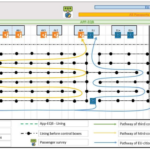With the Entry/Exit System, the EU member states want to create a huge database with fingerprints and facial images. Nothing will come of this for the time being. A phased implementation is also not very realistic.
The introduction of a European biometric system for short-term travellers in the Schengen area, which was planned for November, has to be postponed again. The European Commission had already confirmed this at a conference of EU interior ministers three weeks ago. At that time, it also announced that it would examine a gradual introduction of the system. Now it is becoming clear that this is not possible. The launch could therefore be delayed until next spring.
The Entry/Exit System (EES) requires travellers from countries with which the EU has concluded a visa-free short-stay agreement to provide four fingerprints and a facial image. The aim is to identify people who overstay their short-term visas or commit identity fraud. All EU member states except Cyprus and Ireland as well as the Schengen-associated countries Iceland, Liechtenstein, Norway and Switzerland participate in the EES.
Launch was planned for 2022
The system was originally due to go live in 2022, but the date has been postponed several times. The EU agency responsible for the management of large-scale IT systems (eu-LISA) cited delivery problems with the consortium that was awarded the contract for the EES as the reason.
Germany, France and the Netherlands are responsible for the renewed delay in the implementation of the EES. The three countries have not yet successfully completed the final tests of their national biometric systems. The EU Commissioner for Home Affairs, Ylva Johansson, spoke of “some concerns when it comes to the resilience of the system.”
Johansson had suggested that the other EU states could already start using the system, while the latecomers could take their time to carry out further tests. It would also be conceivable that no biometric data would initially be collected after the launch. For such a “phased approach”, however, the EES Regulation would have to be supplemented and the Schengen Borders Code amended.
“Phased approach” requires new laws
Even if the EU Parliament had no objections to a phased introduction, such a process would take several months. In addition, these changes at EU level would have to be transposed into national law, which would be necessary in all participating countries.
According to information from netzpolitik.org, the EU member states and the Commission now want to follow the “big bang approach” after all. This refers to the simultaneous start of operations at the border crossings of all participants. However, the German, French and Dutch declarations of readiness are missing.
Regardless of which approach is chosen: The earliest the system can go live is three months from now. However, a launch in April 2025 is more realistic.
ETIAS will also be delayed by at least six months
The EES is part of a comprehensive renewal of a total of five biometric databases for travellers, visa holders, asylum seekers and foreign nationals convicted of terrorism. As part of the “Interoperability” project, the fingerprints and facial images collected from the persons concerned are collected in a “Common Identity Repository” and made searchable.
With the EES, the EU member states also want to replace the conventional stamping of passports. An additional Travel Information and Authorisation System (ETIAS) will also allow non-EU citizens wishing to enter the Schengen area for visits, holidays or business trips to register in advance in the EU.
The ETIAS is due to go into operation six months after the EES and is therefore also delayed. The Council of the European Union is to set a new date on 12 December.
Director of eu-LISA resigned
The EU Commission wanted to present a proposal for a “phased approach” to the introduction of the EES by mid-November. As this solution may not be pursued, a new timetable for the “Interoperability” project is likely to be published soon instead.
Here, too, there is a risk of major follow-up problems: All Schengen states have awarded contracts to companies for the renewal of the various biometric databases. The eu-LISA agency has concluded further contracts for the central system. These would all have to be extended. However, it must be known when the EES will finally be launched.
It remains unclear whether the defaulting contractors for the EES can be held liable for the delays. Agnès Diallo, who took over responsibility for the “Interoperability” project as eu-LISA Director in 2023, previously held a number of management positions at Atos. This was also confirmed by the Commission in its response to an enquiry.
For unknown reasons, Diallo refused to take recourse against Atos as the main contractor for the EES. She finally resigned in the summer. Shortly afterwards, the Management Board of eu-LISA appointed an interim head until a new one would be elected.
Image: Model border crossing point with comparison of biometric data (Frontex).





Leave a Reply